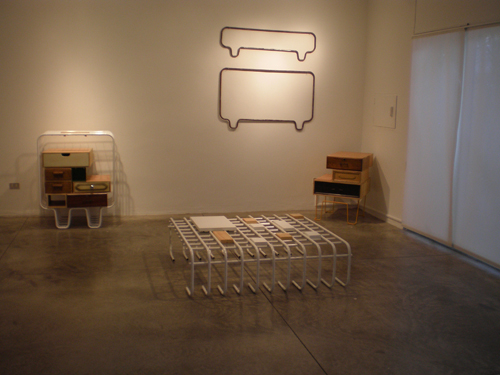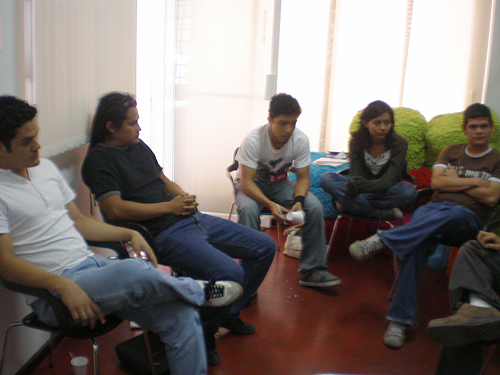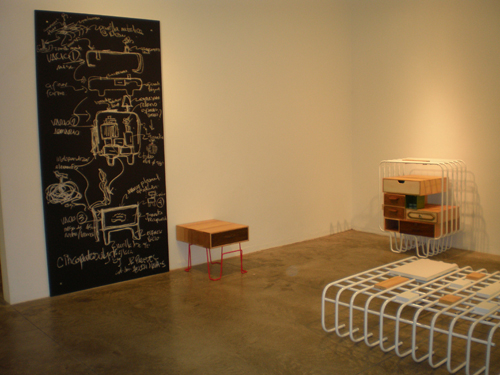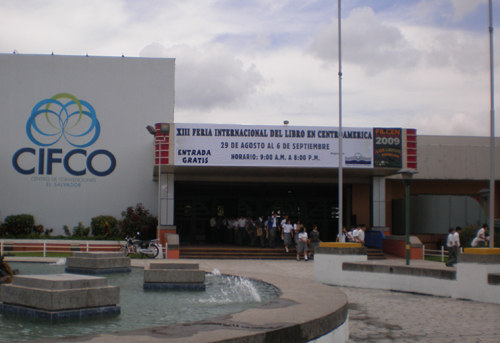Notes on August 2009 Visit to El Salvador, by Eduardo Navas

Detail of the exhibition “Diseñar a diario (Design Day to Day)” on view for the month of August, 2009 at Cultural Center of Spain’s Gallery. Design by local artists.

One of two workshops with participants of Premio Arte Joven, which took place at the Cultural Center of Spain during August 24-29, 2009.
I visited El Salvador for a third time in August to run a couple of workshops for the selected artists of Premio Arte Joven 2009, again under the invitation of Cultural Center of Spain in El Salvador. As I found the workshops quite productive, I will write a separate entry in which I evaluate our discussions. I also met with the artists individually to discuss the ongoing development of their art proposals for the exhibit, which is to take place in October of 2009. The meetings went really well, and I look forward to the realization of the exhibition. I will not be there, but I hope to get some good documentation from the local community.

Detail of the exhibition “Diseñar a diario (Design Day to Day)” on view for the month of August, 2009 at Cultural Center of Spain’s Gallery. Design by local artists.
The Cultural Center’s gallery had a furniture design exhibition on view titled Diseñar a Diario (Design day to day), which presented furniture design by local practitioners. It is perhaps one of the most successful exhibitions I have seen in this space during my three visits this year. The reason being, in my opinion, is that the 3-dimensional space became activated, something I had not experienced in previous exhibitions, which consisted of mainly works on the wall. In this exhibition the furniture design was usually accompanied with corresponding sketches, or at least mock-ups to demonstrate the creative process.
This staging led me to think how the gallery appears to alternate its exhibitions between art and design exhibitions. Part of it I imagine may have to do with the importance of design as a practice in the country. In fact, some of the more active artists at the moment are trained in art as well as design. I realized that in El Salvador Art and Design are not necessarily separated as completely distinct specializations, which is the case in the United States. In this sense the Center’s gallery may be somewhat unique in that it does not try to differentiate so much as to link between the fields of creative production. I will elaborate more on this in my entry on the actual theoretical workshops.

Mónica Mejia, Program Coordinator of the Cultural Center of Spain, introducing Franklin Hernández-Castro, during his presentation.
During my time in San Salvador, I also had the pleasure to attend a lecture by Franklin Hernández-Castro, Ph.D. a designer currently teaching in the department of Design and Architecture at the Universidad Tecnológica de Costa Rica. The lecture was also organized by the Cultural Center of Spain. Hernández-Castro eloquently questioned systems of measurement that have been applied in design since the Greeks. In just over an hour Hernández-Castro moved from Aristotle to Le Corbusier to propose his interpretation of the recurrences of patterns in nature and how Western thought has interpreted them in theories that as questionable as they may be are still being implemented. Hernández-Castro has written a book on the subject titled El Error de Le Corbusier (Le Corbusier’s Flaw).

Wide shot of Hernández-Castro’s presentation.
A couple of days after his presentation I was able to have breakfast with Hernández-Castro and we discussed his conclusions in the book. I learned that he is not necessarily critical, or thinks that there is a flaw in systems of measurement but that there are elements at play in the construction of form that we don’t yet understand. In this regard we discussed the relation of structuralism and poststructuralism as forms of support and reflection on systems of thought and measurement in art and design. I told Hernández-Castro that his position could be considered poststructural, given that, like thinkers in that field, he questioned the apparent comfortable encapsulation of all natural and human-made elements within conceivable measuring models. As I evaluated Hernández-Castro’s book, what I found refreshing is that he questions with the quest for practicality, and function, something not always of concern in more abstract studies of form and aesthetics within the visual arts and art history. The book is a welcomed addition to my own collection.

Entrance of El Salvador’s Convention Center, where the Central American Book Fair was taking place.
Staying on the topic of books, Romeo Galdámez, member of La Fabri-k and Coordinator of Art in the Department of Culture, invited me to attend the annual Central American Book Fair. The fair brings together publications from the region. It took place in El Salvador’s Convention Center. Needless to say I had an amazing afternoon looking through publications that are hard to find outside of the region. I bought a few books, including three important volumes of the national magazine Cultura (Culture), which has been published for over 44 years. The journal is one of the longest running publications in the country.
I was also able to meet with other members from La Fabri-k, including Francisco Zayas, Baltasar Portillo, and Mayra Barraza, and independent designer and artist Antonio Romero, who had just opened his own bar, which he considers in the tradition of social sculpture as an open ended experiment not only of art, but design and culture. They updated me on their projects and hosted me to a number of other events.








